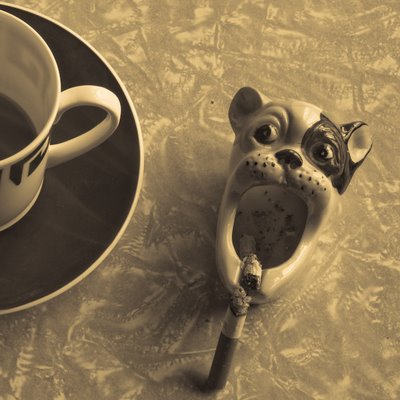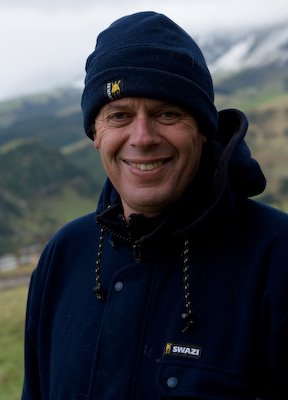Of Prevert and Sudek

DEJEUNER DU MATIN
-Jacques Prévert
Il a mis le café
Dans la tasse
Il a mis le lait
Dans la tasse de café
Il a mis le sucre
Dans le café au lait
Avec la petite cuiller
Il a tourné
Il a bu le café au lait
Et il a reposé la tasse
Sans me parler
Il a alluméUne cigarette
Il a fait des ronds
Avec la fumée
Il a mis les cendres
Dans le cendrier
Sans me parler
Sans me regarder
Il s'est levéIl a mis
Son chapeau sur sa tête
Il a mis
Son manteau de pluie
Parce qu'il pleuvait
Et il est parti
Sous la pluie
Sans une parole
Sans me regarder
Et moi j'ai pris
Ma tête dans ma main
Et j'ai pleuré.
He put the coffee
In the cup
He put the milk
In the coffee cup
He put the sugar
In the café au lait
With a small spoon
He stirred it
He drank the café au lait
And he put the cup back down
Without speaking to me
He lit a cigarette
He made circles
With the smoke
He put the ashes
In the ashtray
Without talking to me
Without looking at me
He got up
He put
His hat upon his head
He put on
His raincoat
Because it was raining
And he left
Beneath the rain
Without a word
Without looking at me
And I, I put
My head in my hands
And I wept.
I have no particular leaning toward…the all too-clearly defined; I prefer the living, the vital, and life is very different from geometry; simplified security has no place in life.
-Josef Sudek(1896-1976)
Kia ora tatou:
You’ve probably never heard of Czechoslovakian photographer Josef Sudek.
Neither had I, until one of my students loaned me a book of his work, one of those huge expensive tomes that you handle with care for fear of doing yourself a mischief. I took it home and began to read. About a fortnight later my student inconsiderately and somewhat agitatedly asked if I was done with it. It was a shame she asked, and I felt obliged to give it back. But I didn't want to. It was one of those books (no, don't ask me, I have long since forgotten the title) that get inside your head. Fortunately, it had a lot of biography on Sudek, so I was able to get some sort of grip on where he was coming from. Born in 1896, he lost his right hand in a battle in the First World War. The injury seems to have affected him quite badly in a psychological sense, and it must certainly have made the act of photographing with a large view camera quite difficult. He is often referred to as “the Poet of Prague,” a reference to the lyrical and often surrealistic nature of his photography. He is also, in many ways, regarded as the master of the still life, and he certainly acknowledged a connection with the great Dutch masters in this area.
As I said, his work really sank in; the simple nature of what he photographed, much of which was immediately around him in his home and garden, and the way in which he structured his picture space. His relationship with light also has to be seen to be believed. There is no doubt that he was a recluse, who never attended the openings of his exhibitions until his last one shortly before his death. During World War II, he rarely if ever left his home in German-occupied Prague. His walled garden protected him from the outside world, and his subject material during that time was the things around him; his garden, classes, ashtrays-all the domestic things in his life. His work, which was quite encyclopaedic, leaves a huge legacy that we can learn from.
As some of you know, my degree is in foreign languages and I majored in French, not the wisest choice from a career perspective, but enriching for all of that and now beginning to feed into my work. At some point we studied the great French poet, Jacques Prévert, who also lived and worked in a similar period. Prévert’s work is at once simple, at once exquisitely detailed, rather like Sudek's photography. I didn't make the connection until yesterday, when for a variety of reasons, Prevert's poem, which I have loved ever since I studied it at university, Déjeuner du Matin came into my head. Put simply, the poem concerns itself with a relationship break-up or possibly morning-after feelings (both ideas can be read into the title), and the last meeting the couple have or will have. I tracked a copy down on the Internet, dug out my rusty French skills and attempted a translation. As so often happens when attempting to translate from a foreign language, much of the subtlety and subtext gets lost, and this is even worse with a poem. Prévert’s style makes it even harder. While it is easy to translate the words and meaning, it does no justice whatsoever to the exquisite use of tone and sound, and the way Prévert plays with words.
So what does this have to do with photography? Well, somehow I knew I wanted to make an image that reflected my awareness of these two masters who probably never knew each other and the feelings their work has for me in this place and time.
I borrowed a cup and saucer and ashtray from the art deco shop down the street, waited for the light and made a series of photographs, using my 90mm shift lens. I wanted an image that had a degree of circularity to it, that in some way visually talked about the way in which life is circular, the idea that what goes around comes around but somehow referenced both Sudek and Prevert.
Download, edit, crop, greyscale (they didn’t have colour in those days). Then add some split toning; a little blue into the shadows to accent the feeling and brown into the highlights for further sombreness and crop it 1:1 to reflect the square format cameras they shot with back then( sic. Rolleiflex). I still wasn’t happy that it recorded what I was feeling and wanting to say, so I redid the crop (in Lightroom) and used the Antique Greyscale function to get that 30’s feeling and also the idea of a brown study. The finished image is, well, a start point.
I can see why Edward Steichen spent a year photographing the same cup and saucer.
Ka kite ano.


6 Comments:
wow you have alot of spare time
Kia ora tatou:
For those of you who don't know, Alex is my very special and dear son, a very talented photographer in his own right.Actually he has more talent than me(it makes me proud to be able to say that).
ka kite ano
I've been out of country for 2 weeks- and missed your blog.I love today's post, BUT your Maniototo ramblings are amazing- you have captured the magnificence and the serenity of the area. I will rise to the bait(APSNZ) and would love to be included in the exercise.
take care.
Your blogs have changed- you really are like a bird released....
Tony: I'd heard of Sudek - from you - and funnily enough only a few days ago was thinking about him, doing all that photography during WW II without going beyond the walls of his garden. (It was when I was wondering what sort of photography project I could do without going far from home.) I've just been looking at some of his photographs on the internet, and I see what you mean about his relationship with light. No wonder they called him "the Poet of Prague."
I'd never come across Jacques Prévert. French at school never went that far. I did manage to dredge up enough, though, to be able to read the poem in its original language, because the vocabulary is very simple. (I felt really chuffed!) I agree about the difficulty of translating poetry. This poem is powerful. What a simple but profound account of a breakfast, and how poignant the repeated phrases "without speaking to me ... without looking at me." But I think the poem's effect is much enhanced by its sounds: a pattern of repeated, or different but very similar, vowel sounds, and the frequent repetition of a small number of consonants - for example, p, m s and soft c (particularly from the lines "Il a mis Son manteau de pluie"... ) The English words don't contain this characteristic to anything like the same extent, and to try to replicate it would sound contrived and destroy the simplicity. A professional translator of poetry must have a very difficult job!
I like the idea of linking these two contemporaries of different nationalities and practising different arts but, if the poem you've quoted is an example of Prévert's style, both able to take something quite mundane and give it a poetic significance that many of us would probably never see.
As to your image: why did you choose the ashtray you did? If I'd had this idea I think I would have been looking for something round, to match the cup and saucer. I'm intrigued.
hi Peregrina:
As for the ashtray...well, it was the right one. I knew that when I saw it. A round one, while compositionally more "together" somehow didn't quite say it for me. I wanted something a bit more symbolic/metaphorical. The cat, with its open-wide mouth, seemed to me to allude to the feelings expressed in the poem, the sadness of such an event. At times like this, both parties will circle around the event. He was doing the same thing. Hence the positioning of the ashtray in relationship to the cup.
Does that help?
Ka kite ano
Thanks, Tony. Yes, I see it now. I was so excited by the poem that I didn't give the image proper attention. (Sorry!) The ashtray seemed unrelated to the cup and saucer. What I hadn't noticed (and it seems surprising now) was that the two objects are linked by an invisible line between the cat's eyes and the coffee cup. I like the way the cigarette was left to burn on the lip of the ashtray until what was left tipped off. It gives more to wonder about in the situation described.
Post a Comment
<< Home